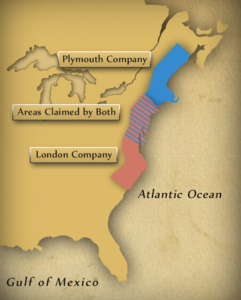Netherlands
The Netherlands was an appealing place for protestants to seek relief from persecution. Seven Dutch provinces in the Spanish Netherlands formed a mutual alliance and revolted against Spanish rule. That alliance established the Dutch Republic in 1581. The small republic of around 1.5 million inhabitants distinguished itself by providing religious and social tolerance towards different religions and ideas (freedom of thought). They also controlled a vast network of seafaring trade routes through its trading company, the Dutch East India Company.
Leyden, Netherlands

Jesse de Forest came to Leyden from France in 1615. Presumably still a merchant in woolen cloth, he had been a dyer for seven years. His brothers, who had arrived earlier, were already established there.
Philippe du Trieux, an acquaintance of Jesse de Forest, was also a merchant in woolen cloth and a dyer. As a French Huguenot, Philippe, like Jesse, fled religious persecution in the Walloon region of France and Belgium to Leyden, Netherlands.
In Leyden, Jesse and Marie lived on Bradstreet, where they had four more children. Jesse, Isaac, Israel, and Philippe made ten children in all—a large number for a refugee to care for. Jesse de Forest struggled to provide for his large family. In 1618, he owed fifty florins in rent, forcing him to pledge his furniture and dyeing cauldron. With a large family and only a dyer’s business to support them, Jesse sought better opportunities.
During their stay in Leyden, Jesse de Forest and Philippe du Trieux met other refugees, including the Tilley and Ford families, who were planning to move again.

John and Joan (Hurst) Tilley, along with their daughter Elizabeth, moved from Henlow, Bedfordshire, England to Amsterdam seeking freedom from Protestant persecution. They joined a group called “Saints” who shared their concerns and aspirations.
William and Martha (Unknown) Ford, from County Devon, England, also joined the group. William and Martha married around 1617 in England and soon had two children, including a daughter named Martha. The “Saints” then moved to Leyden, Netherlands.
In Leyden, William and Martha Ford, along with the other “Saints,” found religious and social tolerance and menial, low-paying jobs. However, Holland’s easygoing, cosmopolitan atmosphere proved alarmingly seductive to some of the Saints’ children. For the strict, devout Separatists, this was unacceptable. They wanted to maintain their ways as Englishmen and have their children grow up in their traditions.
After much discussion and planning, the Tilley and Ford families, along with the rest of the English group, decided to move again. This time, they sought a place without government interference or worldly distractions. They aimed to establish a new church separate from the Church of England in the “New World” across the Atlantic Ocean.
The English group received warnings about the hardships they would face in the New World. They were told about the risks of famine, nakedness, sores, sickness, and grievous diseases. They were cautioned about encountering cruel, barbarous, and treacherous savages who would show no mercy. Despite these warnings, their conviction that God wanted them to go held sway. “We verily believe and trust the Lord is with us,” they wrote, “and that he will graciously prosper our endeavors, according to the simplicity of our hearts therein.”
By 1617, they were already raising money and researching passage to the New World. The following year, their decision was cemented. In 1618, William Brewster published a tract criticizing the Anglican Church. James I sent officials to arrest him, but the congregation hid him. This incident intensified their efforts to move faster and further away from the reach of James I.

Also in Leyden were John Carver and his wife Mary. They were from the Dutch speaking, Flemish Region of Belgium (or Flanders). Carver was part of the Flemish Walloon community that were fleeing religious persecution in their homeland of Hainaut. In Leyden they joined the English Puritan separatists that came to Holland around 1607. The Carvers were members of the congregation of the Walloon church in Leyden, Holland. John Carver was the deacon of the Separatists church. He was very wealthy and had 5 servants.
The joint-stock company called the Plymouth Company was founded by English Puritans who were part of a congregation led by William Bradford. They became known as the Pilgrims. John Carver provided much of his personal fortune to invest in the Plymouth Company. The Plymouth Bay Colony obtained a land patent from the Plymouth Company in June 1619.
Carver had the task of organizing the voyage and negotiating funding. In order to finance the voyage Carver made contact with a merchant adventurer named Thomas Weston. Weston matched the would-be colonists with investors. He put together a deal for them. Carver went to Southampton in June 1620 purchasing supplies for the Mayflower voyage.


Weston recruited other economic migrants to help the colonists establish a New World community and generate profit for investors. Consequently, the Pilgrims had to accept fellow migrants who sought commercial success but did not share their separatist beliefs. These individuals made up half of the emigrating group. Coming from various backgrounds, they brought skills and talents Weston deemed useful. They included merchants, craftsmen, indentured servants, and orphaned children, whom the Pilgrims called “strangers.”
With John Carver’s financial help, the Saints bought a small ship, the Speedwell. In the summer of 1620, they purchased the 43-year-old, two-masted Speedwell and leased the 180-ton cargo vessel, Mayflower, making significant progress with their plans.
Later, in the fall, the Tilleys and the Fords traveled 20 miles south to Delfshaven, Netherlands, then sailed under Captain Reynolds to Southampton, England, to meet the Mayflower. The Speedwell was already leaking.





